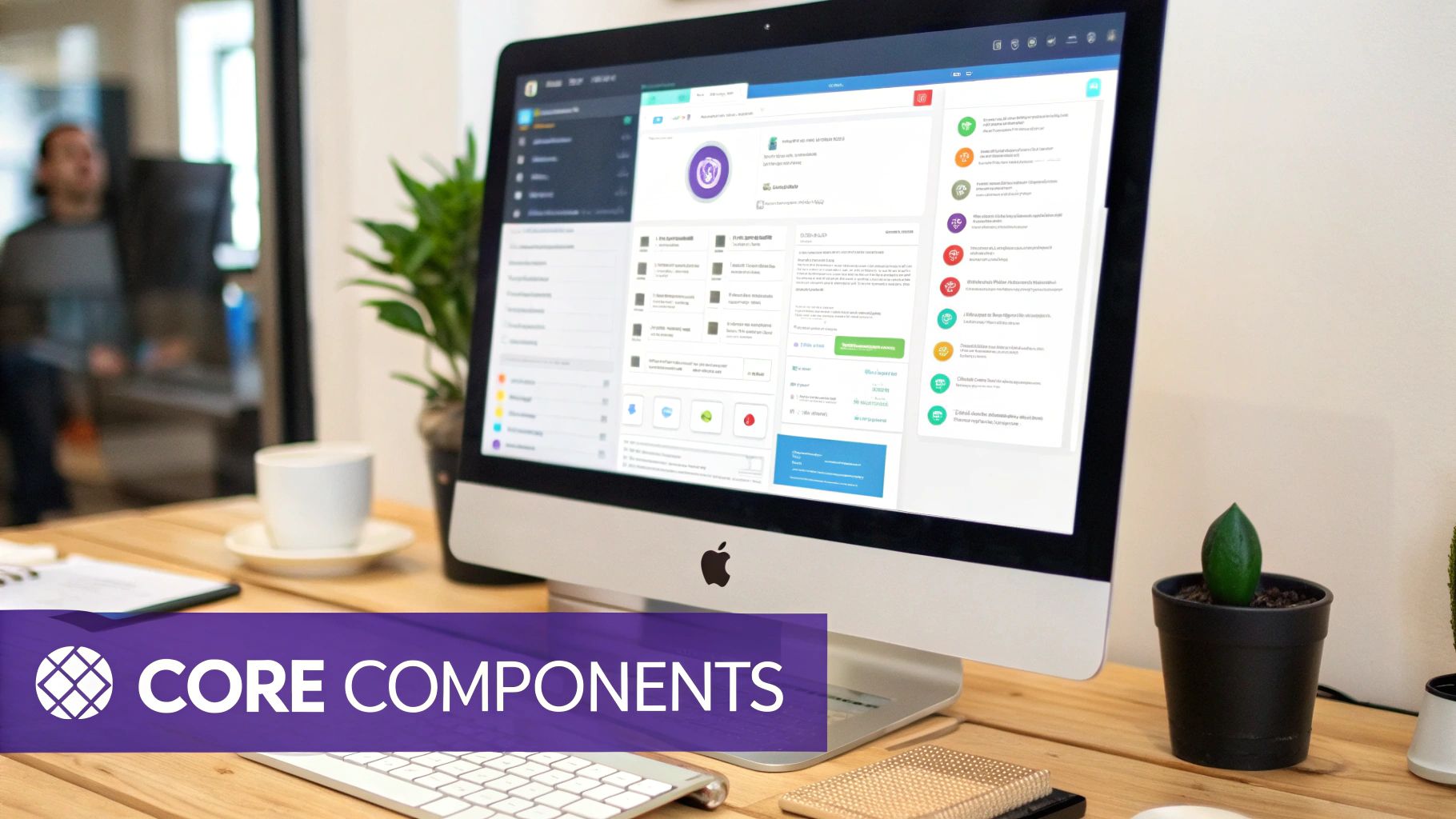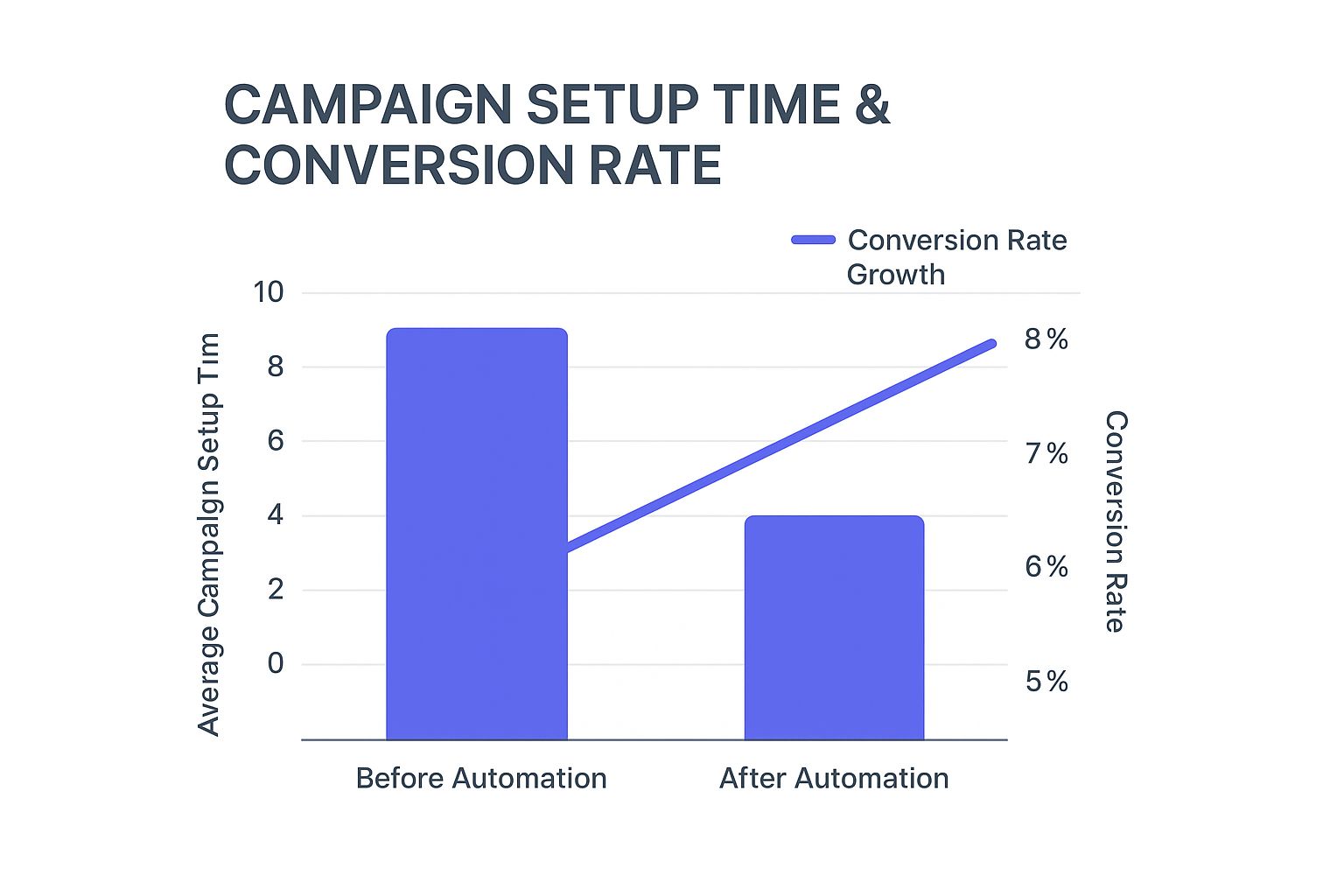Marketing Workflow Automation Strategies That Drive Results
Master marketing workflow automation with proven strategies from industry experts. Discover practical approaches to scale campaigns efficiently.
Posted by
Understanding Marketing Workflow Automation That Actually Works
Many businesses grapple with repetitive marketing tasks that drain valuable time and resources. Marketing teams often find themselves stuck managing manual processes instead of focusing on strategic initiatives. This is where marketing workflow automation comes in. It's a fundamental change in how marketing operates, not just another industry buzzword.
Identifying Automation Opportunities
Savvy businesses understand that automation isn't a one-size-fits-all solution for every marketing process. Some tasks still require a personal touch. The key is identifying repetitive, time-consuming activities that are suitable for automation. Sending welcome emails to new subscribers, for instance, is a perfect example. Automating this process frees up your team to focus on personalized interactions and developing strategic campaigns.
Core Components of Effective Automation
Several key components underpin effective marketing workflow automation. Trigger-based campaigns, for example, initiate actions based on specific customer behaviors. These behaviors could include visiting a specific web page or abandoning a shopping cart. This allows for timely and relevant communication with customers. Multi-channel orchestration ensures consistent messaging across various platforms, such as email, social media, SMS, and push notifications.
Another vital component is customer journey mapping. Understanding the different stages of a customer's interaction with your brand helps tailor automated workflows. This ensures customers receive the right information at the right time. This personalized approach can significantly improve customer engagement and conversion rates. You might be interested in: How to master marketing automation strategies.
Real-World Success Stories
Many companies have successfully implemented marketing workflow automation to achieve impressive results. By automating tasks like lead nurturing and social media posting, these businesses have freed up their teams to focus on strategy and creative projects. This has resulted in increased productivity, improved campaign performance, and higher customer satisfaction. The increasing demand for marketing automation also highlights its importance. By 2025, projections indicate that 79% of businesses will use some form of marketing automation, demonstrating its widespread adoption. Find more detailed statistics here.
The Power of Automated Workflows
Automated workflows streamline marketing operations. They ensure consistent task execution, reduce manual errors, and provide valuable data insights. This allows marketing teams to track campaign performance, identify areas for improvement, and optimize their strategies for better results. By embracing marketing workflow automation, businesses can transform their marketing operations, increase efficiency, and achieve significant growth.
Building Marketing Workflow Automation That Pays For Itself

Thinking differently about marketing workflow automation is key. Instead of seeing it as another cost, view it as a smart investment ready to deliver real returns. This means thinking beyond the initial cost savings and focusing on the long-term financial benefits. How can you measure this and ensure your automation efforts are truly worthwhile?
Calculating the True Cost-Benefit of Automation
Figuring out the Return on Investment (ROI) of marketing workflow automation involves more than just tracking time saved. While less manual work is important, the real value is in the less obvious advantages. These include better lead quality, fewer errors, and a boost in customer lifetime value. These contribute significantly to the overall profitability of your marketing.
For example, automating your lead nurturing ensures consistent contact with potential customers. This can lead to higher conversion rates and, ultimately, more revenue.
To effectively build marketing workflow automation, consider using video ad automation. This can be a helpful resource for improving your campaign results.
Case Studies: Automation Success in Action
Many businesses have used marketing workflow automation to create reliable revenue streams and reduce acquisition costs. These real-world examples show the tangible financial benefits of automation. One company automated their email marketing, leading to a 20% increase in sales conversions in just the first quarter.
Another business automated their social media posting, resulting in a 15% increase in website traffic over six months. These success stories clearly show the power of strategic automation.
ROI Models and Budget Allocation Strategies
Understanding proven ROI models is crucial for justifying automation investments and getting the budget you need. This means identifying key performance indicators (KPIs) and tracking them over time. This helps you show the value of automation to stakeholders and justify continued investment in automation technologies.
By focusing on metrics like conversion rates, lead generation costs, and customer lifetime value, you can demonstrate the financial benefits of your automation strategy. Strategically allocating your budget to automation initiatives with the highest potential ROI is essential for maximizing returns.
Maximizing Returns: Short-Term Gains and Long-Term Growth
The best automation investments provide both immediate efficiency gains and long-term growth. This means streamlining current processes while setting the stage for future expansion. Automating repetitive tasks frees up your team to focus on strategic work that drives long-term value.
This approach to automation contributes to sustained growth and higher profitability. The global marketing automation market is expected to grow from $5.65 billion in 2024 to $14.55 billion by 2031, at a CAGR of 12.55%. Companies using marketing automation often see a return of $5.44 for every dollar spent, highlighting the significant ROI. Learn more about marketing automation ROI. Understanding these factors helps you build a marketing workflow automation strategy that delivers real financial benefits.
Leveraging AI For Smarter Marketing Workflow Automation

Artificial intelligence (AI) is transforming marketing. It's pushing marketing workflow automation beyond simple tasks and into data-driven decisions. This allows marketers to personalize at scale, forging stronger customer connections. AI can significantly boost your marketing automation efforts. For practical examples, check out this article on AI in Ecommerce Examples.
Intelligent Content Creation and Predictive Lead Scoring
Smart marketers are already using AI to create intelligent content. This means content that adapts to individual preferences. Imagine a website that customizes its message based on a visitor's browsing history or demographics. This personalized approach boosts engagement and conversions.
AI-powered predictive lead scoring also surpasses traditional methods. These systems learn and evolve, identifying high-potential leads with greater precision. This allows sales teams to focus on the most promising prospects.
Dynamic Campaign Optimization: Responding in Real-Time
AI supercharges dynamic campaign optimization. Instead of static campaigns, algorithms analyze customer behavior in real-time and adjust campaigns accordingly. This might involve changing bidding strategies for ads, tailoring email subject lines, or even altering website content to optimize conversions. The ability to react instantly to shifting market conditions and preferences is a major competitive advantage.
Implementing AI-Powered Tools: Practical Approaches
While AI’s potential is vast, implementing AI-powered tools requires a smart approach. Begin by understanding the capabilities and limitations of different AI technologies. Choosing the right tools for your specific needs and integrating them smoothly into your existing workflows is vital.
Training your team is also crucial. Focus on practical applications and show them how AI can improve their daily work. This will encourage adoption and maximize the benefits of automation. By tracking AI's impact on key metrics like campaign performance and customer engagement, you can continuously optimize your automation strategy and prove its value.
As of 2025, 77% of marketers are expected to use AI-powered automation for personalized content, reflecting a significant move toward more sophisticated marketing strategies. Further highlighting automation's importance, 98% of B2B marketers consider marketing automation essential for success, emphasizing its role in improving campaign effectiveness and customer engagement. Dive deeper into these stats here.
Choosing Marketing Workflow Automation Tools That Fit
Finding the perfect marketing automation platform can be tough with so many options out there. This section helps you cut through the clutter and focus on what truly matters for your business. We'll guide you through evaluating platforms based on your specific needs and help you avoid costly mistakes.

The infographic above illustrates the impact of marketing workflow automation. It compares campaign setup times and conversion rates before and after automation.
Automating workflows significantly reduces setup time from 10 hours to a mere 4 hours. At the same time, conversion rates increase from 5% to 8%. This demonstrates how automation can boost efficiency and improve campaign performance.
Evaluating Platforms Based on Your Needs
Choosing the right marketing workflow automation tool begins with understanding your business. Consider your team's size, technical expertise, and existing marketing processes. A small business with a tight budget will have different requirements than a large corporation.
For instance, a smaller team might prioritize user-friendliness and affordability. A larger team, on the other hand, might need more advanced features and integrations with existing systems.
To help you compare available options, take a look at the table below:
Marketing Automation Platform Comparison
A detailed comparison of popular marketing automation platforms showing features, pricing tiers, and ideal use cases
| Platform | Key Features | Best For | Starting Price | Integration Score |
|---|---|---|---|---|
| HubSpot | Email marketing, CRM, social media management, landing pages | Small to medium businesses | $450/month | 9/10 |
| Marketo | Lead management, email marketing, campaign management, analytics | Enterprise businesses | $899/month | 8/10 |
| Pardot | B2B marketing automation, lead nurturing, email marketing, sales alignment | B2B businesses | $1,250/month | 7/10 |
| ActiveCampaign | Email marketing, automation, CRM, sales automation | Small to medium businesses | $29/month | 8/10 |
| Mailchimp | Email marketing, automation, landing pages, website builder | Small businesses | Free plan available | 7/10 |
This table summarizes key features and pricing to help you start your research. Be sure to explore each platform further to determine the best fit for your specific needs.
Key Features to Look For
Several key features differentiate truly effective platforms from overly complicated ones. Integration capabilities are essential, enabling your automation tool to work seamlessly with your existing CRM, email marketing platform, and other crucial software. Prioritize platforms that integrate with your current tools.
Scalability is also important. The platform you choose should be able to grow with your business, handling increasing data and complex workflows. User experience is another crucial factor. An intuitive interface and easy-to-use features will encourage your team to adopt the new system.
Implementation Timelines and Common Challenges
Implementing marketing workflow automation takes planning. Realistic timelines and strategies for overcoming common challenges are essential. While the timeline will vary based on the platform and your business, set clear milestones and dedicate resources for training and integration.
Data migration and integration can present hurdles. Make sure your platform can handle data transfer without disrupting operations. Change management is also vital. Prepare your team for the new tools and provide ample training.
EndorseFlow offers seamless integration with popular marketing tools for managing testimonials and social media content. Learn more about streamlining your workflow here.
Maximizing Platform Capabilities and Avoiding Mistakes
Choosing the right marketing workflow automation platform is just the beginning. To unlock its full potential, you need a clear automation strategy. Identify key processes to automate and set measurable goals. Start simple and gradually increase complexity as your team gains experience.
Regularly review and optimize your automated workflows. Analyze performance data and identify bottlenecks. Make adjustments as needed to maintain effectiveness. With a strategic approach and the right tools, you can harness the power of marketing workflow automation to improve efficiency and ROI.
Implementing Marketing Workflow Automation Successfully

Many automation projects falter when moving from planning to action. This section provides a practical guide, based on the successes of companies using marketing workflow automation. We'll focus on actionable strategies, not just theory.
Mapping Your Processes: The Foundation of Success
Understanding your current workflows is the first step to successful automation. This involves process mapping, visually representing each step in your marketing process. It's like creating a blueprint for your marketing operations. This clarifies which processes are suitable for automation and which need human input.
For example, mapping your lead nurturing process might reveal repetitive email sequences perfect for automation. This careful approach prevents automating ineffective processes and prepares for streamlined operations.
Deployment and the Importance of Change Management
After mapping, the next step is deployment. A phased approach, beginning with a pilot project, minimizes disruption. Effective change management is also crucial. Prepare your team with training and open communication about automation's benefits. This builds acceptance and reduces resistance to new technology.
Involving your team early, addressing their concerns, and showing how automation simplifies their work makes the transition smoother. Proper implementation is key. Companies with structured marketing automation strategies see 451% higher qualified leads and 34% faster sales cycles. Learn more about automation implementation success.
Testing and Optimization: Continuous Improvement
After deploying automated workflows, continuous testing and optimization are essential. This means monitoring Key Performance Indicators (KPIs) and adapting based on data insights. It's like fine-tuning a machine for peak performance.
This ensures your automated workflows stay effective and adapt to market changes. Regularly analyzing data, finding bottlenecks, and adjusting as needed ensures ongoing improvement. Check out our guide on How to master marketing automation workflows.
Real Implementation Stories: Navigating Challenges
Learning how other teams handled implementation challenges offers valuable lessons. Data integration is a common hurdle. Successfully integrating your automation platform with existing systems ensures smooth data flow. Managing workflow complexity is another challenge. Breaking down complex processes into smaller, automated tasks simplifies implementation and troubleshooting.
Finally, securing stakeholder buy-in is crucial. Showing automation's value with clear ROI projections and success metrics secures needed resources and support. Addressing these challenges, learning from others, and focusing on continuous improvement are key to successful marketing workflow automation. By following this guide, businesses can transform marketing operations, improve efficiency, and unlock automation's full potential.
Measuring What Matters In Marketing Workflow Automation
Success with marketing workflow automation isn't about tracking every single metric. It's about focusing on the data that truly matters. Instead of vanity metrics like follower counts, prioritize key performance indicators (KPIs) that inform your business decisions and demonstrate real impact. This requires setting benchmarks and monitoring the efficiency gains that directly contribute to your goals.
Establishing Baseline Benchmarks: Knowing Your Starting Point
Before automating your marketing workflows, establish clear baseline benchmarks for your KPIs. This initial assessment provides a foundation for measuring the effectiveness of your automation efforts. For example, track metrics like your current email open rates, website conversion rates, and lead generation costs. Understanding your current performance provides context for future improvements and allows you to clearly see the impact of automation.
Also, consider tracking factors like the time spent on manual marketing tasks and the frequency of errors. This will help you quantify the efficiency gains achieved through automation. Want to learn more about automating your marketing? Check out this helpful resource: Learn more about marketing automation for small businesses.
Tracking Efficiency Gains: Measuring What Automation Improves
Once your marketing automation is up and running, closely monitor how it affects your baseline metrics. Are your email open rates increasing? Is your lead generation process becoming faster? Is your team spending less time on tedious manual tasks? Answering these questions will reveal the true value of your automation investment.
For example, if your lead nurturing workflow previously required 10 hours of manual work per week, track how much time is saved after automating the process. Quantifying these time savings demonstrates tangible efficiency gains and justifies the investment in automation technology.
Measuring Automation's Impact on Business Outcomes
Beyond simply improving efficiency, it's crucial to track how automation influences your overall business outcomes. Connect your marketing KPIs to broader business objectives like revenue growth and customer acquisition cost. For instance, if your automated lead nurturing workflows result in a 15% increase in sales qualified leads, this directly contributes to revenue generation.
This connection highlights the strategic importance of marketing automation beyond just saving time. It demonstrates how automation can directly impact your bottom line and contribute to business growth.
Advanced Analytics: Understanding the Deeper Impact
Gain deeper insights through advanced analytics. Customer journey optimization involves understanding how automation influences customer behavior and identifies areas for improving the customer experience.
This goes beyond simply tracking conversion rates; it helps you understand why customers convert (or don't). Additionally, exploring campaign attribution allows for a more precise understanding of which marketing touchpoints are driving the most valuable conversions.
Automated Reporting and Data Feedback Loops
Set up automated reporting systems to gain consistent performance insights and quickly identify areas for improvement. Automating your reports saves time and ensures accuracy by eliminating manual reporting processes.
Equally important is establishing data feedback loops. These loops allow you to continuously refine your automated workflows based on the latest performance data. By consistently adjusting your strategies based on real-time insights, you can ensure your automation remains effective and aligned with your evolving business goals.
The following table provides a helpful overview of important marketing automation KPIs and benchmarks:
Marketing Automation KPIs And Benchmarks
Essential metrics for measuring marketing automation success with industry benchmarks and measurement frequency
| KPI Category | Key Metrics | Industry Benchmark | Measurement Frequency | Success Threshold |
|---|---|---|---|---|
| Email Marketing | Open Rate, Click-Through Rate, Conversion Rate | Open Rate: 20%, CTR: 2%, Conversion Rate: 2% | Weekly/Monthly | Exceeding industry benchmarks by 10-20% |
| Lead Generation | Cost per Lead, Lead Conversion Rate | CPL: $50, Lead Conversion Rate: 10% | Weekly/Monthly | Reducing CPL by 15%, Increasing Lead Conversion Rate by 20% |
| Website Engagement | Conversion Rate, Time on Site, Bounce Rate | Conversion Rate: 2%, Time on Site: 2 minutes, Bounce Rate: 40% | Weekly/Monthly | Improving Conversion Rate by 10%, Increasing Time on Site by 15%, Reducing Bounce Rate by 10% |
This table summarizes key metrics to track, industry benchmarks for comparison, recommended measurement frequency, and potential success thresholds. By monitoring these key areas, you can ensure your marketing workflow automation strategy delivers measurable results and contributes to real business value.
Ready to streamline your testimonial collection and social media management? Simplify your workflows and boost your online presence with EndorseFlow.